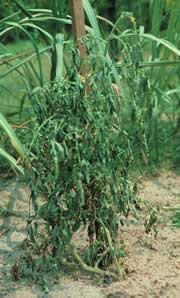Deadly plant bug sequenced

Southern wilt affects more than 200 species around the world. <br>© D. Gay <br>
Researchers grapple with wilt-causing bacteria
It’s the Mike Tyson of plant bacteria,” says Gerry Saddler, of the Scottish Agricultural Science Agency, Edinburgh.
Saddler is referring to Ralstonia solanacearum, the cause of southern bacterial wilt possibly the most important plant disease in the world. French researchers have now sequenced the bacteria’s genome – information that should lead to a better understanding of plant disease, and perhaps new ways to fight it1.
Southern wilt or brown rot affects more than 200 species around the world, including potatoes, bananas, mulberry trees and ginger. Entering plants through their roots, Ralstonia mounts a deadly assault on their fluid and nutrient transport networks.
The bacterium’s genome sequence gives some clues to its versatility. An unusually large number of genes enable it to attach to plant cells and inject them with its proteins. It may use different genes on different host species.
Finding the plant molecules that these two processes latch onto, “might allow us to engineer resistant varieties,” says Christian Boucher of the National Agronomic Research Institute in Toulouse who led the sequencing project.
The genome should also provide insight into many other plant diseases that employ similar infection strategies. “It’ll revolutionize molecular plant pathology,” says plant biologist James Alfano of the University of Nebraska, Lincoln.
Off switch
Knowing the genes that cause disease might also allow us to switch them off. Ralstonia can do this itself, and live in plants without harming them.
Julian Smith, of CABI Bioscience in Egham, England, is trying to engineer benign forms of the bacterium with which to inoculate plants against the lethal form. Early results are promising, and the team has permission, but not funds, to run trials in Kenya and South Africa.
Other potential routes of attack are the genes that Ralstonia use to make chemicals to kill each other, says Smith. Engineering these into potato plants “could have enormous applications”, he says.
Rotten luck
At present there is little we can do to combat Ralstonia aside from try to prevent its spread. Conventional plant breeding has largely failed to create resistant crops – perhaps because the bacterium uses many genes to bring about disease. The bug’s wide host range and ability to survive in the soil for several years makes it difficult to evade by crop rotation.
The microbe can wipe out entire fields. In parts of Florida, for example, it has killed 75% of the potato crop. “Fields got so heavily infested that people abandoned them,” says plant pathologist Tim Denny of the University of Georgia, Athens.
Ralstonia prefers warm weather, but a cold-tolerant strain from Andean potatoes reached Europe and North America in the 1990s. This strain can spread via rivers and has since infected wild plants, where it does no harm.
Seed-potato distribution is now tightly monitored. “People are very concerned that the pathogen might escape,” says Denny. Global warming might be aiding its spread.
References
- Salanoubat, M. Genome sequence of the plant pathogen Ralstonia solanacearum. Nature, 415, 497 – 502, (2002).
Media Contact
All latest news from the category: Life Sciences and Chemistry
Articles and reports from the Life Sciences and chemistry area deal with applied and basic research into modern biology, chemistry and human medicine.
Valuable information can be found on a range of life sciences fields including bacteriology, biochemistry, bionics, bioinformatics, biophysics, biotechnology, genetics, geobotany, human biology, marine biology, microbiology, molecular biology, cellular biology, zoology, bioinorganic chemistry, microchemistry and environmental chemistry.
Newest articles

High-energy-density aqueous battery based on halogen multi-electron transfer
Traditional non-aqueous lithium-ion batteries have a high energy density, but their safety is compromised due to the flammable organic electrolytes they utilize. Aqueous batteries use water as the solvent for…

First-ever combined heart pump and pig kidney transplant
…gives new hope to patient with terminal illness. Surgeons at NYU Langone Health performed the first-ever combined mechanical heart pump and gene-edited pig kidney transplant surgery in a 54-year-old woman…

Biophysics: Testing how well biomarkers work
LMU researchers have developed a method to determine how reliably target proteins can be labeled using super-resolution fluorescence microscopy. Modern microscopy techniques make it possible to examine the inner workings…





















